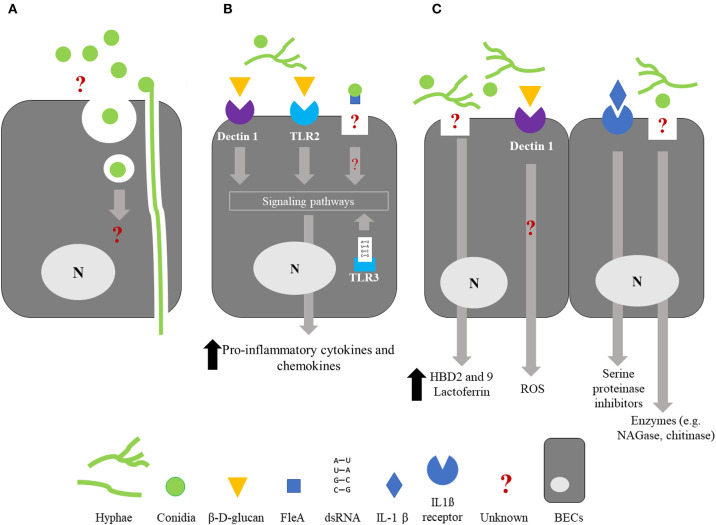Figure 2.
Summary of the interactions between bronchial epithelial cells and Aspergillus fumigatus. For clarity, it should be noted that the schematized epithelial cells are not polarized. (A) Internalization; BECs are able to internalized A. fumigatus conidia but the molecular mechanisms involved in this phenomenon and the fate of the internalized conidia are still unknown. An alternative way of penetration of the hyphae through an actin channel within the cell has been proposed. (B) Cytokine/chemokine release; Recognition of β-D-glucan by BECs through the membrane receptors Dectin-1 and TLR2, and recognition of A. fumigatus dsRNA by the endosomal receptor TLR3 result in the activation of intracellular signaling pathways and a significant increase in the release of proinflammatory cytokines and chemokines, leading to phagocyte recruitment. FleA lectin, expressed on the surface of A. fumigatus conidia, induces IL-8 synthesis by BECs and binding of the conidia to airway mucins. Recognition of FleA by BEC induces the inhibition of conidium germination. (C) Bioactive molecules potentially active against A. fumigatus; BECs synthetize antimicrobials molecules such as defensins HBD2 and HBD9, lactoferrin, reactive oxygen species (ROS), SLPI, ESI, and chitinase in response to A. fumigatus infection or inflammatory challenge. Until now, an antifungal activity has only been described for lactoferrin, ROS, SLPI, ESI, and chitinase. BECs, Bronchial epithelial cells; SLPI, Secretory leukocyte proteinase inhibitor; ESI, Elastase-specific inhibitor; NAGase, N-Acetyl-β-d-glucosaminidase; ROS, Reactive oxygen species; N, nucleus.

